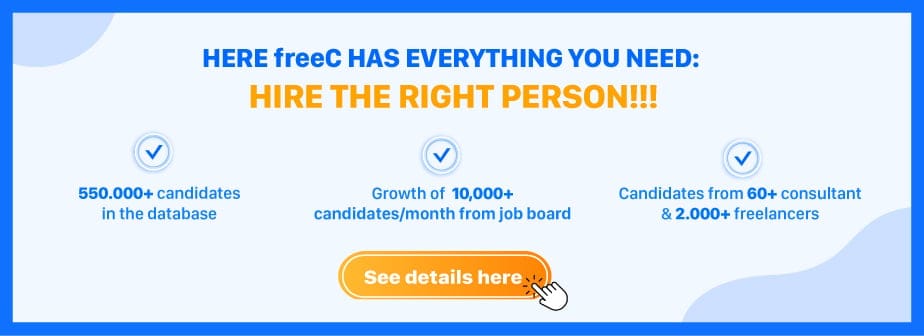One of the key responsibilities of HR professionals is recruiting high-quality talent for their organizations. Making a wrong hire can be costly in terms of both money and time, leading to decreased productivity and morale within the team. In this comprehensive guide, freeC will walk you through a step-by-step process to attract, identify, and select the best candidates, ensuring you avoid hiring mistakes and make wise hiring decisions.
Step 1: Clearly Define Recruitment Needs and Objectives
Before diving into the recruitment process, it is essential to have a clear understanding of your organization’s recruitment needs and objectives:
- Analyze the strengths and weaknesses of your current team to identify skill gaps and determine the roles you need to fill.
- Collaborate with department managers and stakeholders to understand specific requirements and expectations for each position.
- Align your recruitment goals with the overall objectives and long-term strategy of your company.
For example, suppose you are working for a growing technology startup. In that case, your recruitment goal might be recruiting high-quality talent as User Interface Developer who can contribute to developing advanced web applications for your customers.
Step 2: Craft Accurate and Compelling Job Descriptions
Building accurate and compelling job descriptions is crucial for attracting suitable candidates:
- Clearly outline the responsibilities, required skills, and qualifications for the position.
- Highlight unique selling points of your company, such as a positive work culture, career development opportunities, and employee benefits.
- Avoid using jargon or overly complex language that can discourage potential candidates.
For example, if you are hiring a Sales Manager, your job description should mention their core responsibilities, such as leading the sales team, setting sales targets, and developing strategies to achieve business goals. Additionally, emphasize your company’s commission structure and career advancement opportunities.
Step 3: Employ Unique Candidate Sourcing Methods
To find high-quality talent, explore different channels and sourcing strategies:
- Utilize online job boards, industry-specific platforms, and professional networks to reach a wider pool of candidates.
- Leverage social media platforms, particularly LinkedIn, to showcase your job opportunities and attract potential candidates.
- Attend job fairs, industry events, and networking sessions to meet potential candidates in person and build relationships.
- Encourage employee referrals and provide incentives for successful referrals.
For example, when searching for a Content Writer, you can post the job on popular job boards, share it on your company’s LinkedIn page, and ask your Content Writing team to refer qualified candidates from their connections.
Step 4: Carefully Screen Resumes and Applications
Screening resumes and applications is an important step to create a shortlist of suitable candidates:
- Thoroughly review each resume, looking for relevant experience, educational background, and related skills.
- Consider any achievements, certifications, or additional extracurricular activities that demonstrate the candidate’s capabilities.
- Create a checklist to evaluate the key requirements and qualifications consistently and fairly.
For example, when hiring a Project Coordinator, review their resume to see if they have experience in project management, proficiency in relevant software, and strong organizational skills.
Step 5: Conduct Behavioral Interviews (Competency-based Interviews)
Behavioral interviews help assess candidates’ past performance and capabilities, which can be indicative of their future performance:
- Prepare a set of interview questions tailored to the job requirements and competencies.
- Ask candidates to share specific examples from their past experiences to demonstrate how they handled challenging situations.
- Focus on evaluating skills such as problem-solving, teamwork, communication, and adaptability.
For example, in a behavioral interview for a Customer Service Representative, request candidates to describe how they handled a difficult customer situation and resolved the issue while maintaining a positive customer experience.

Step 6: Assess Technical and Professional Skills
For roles that require specific technical skills, it is important to assess candidates’ proficiency:
- Manage assessments, tests, or technical assignments to evaluate their practical knowledge and problem-solving abilities.
- Use coding challenges, case studies, or simulations to assess candidates’ abilities to perform specific tasks.
- Seek input and insights from industry experts or experienced staff members during the technical evaluation process.
For example, when hiring a Graphic Designer, ask candidates to submit portfolios or complete design tasks to evaluate their creativity, attention to detail, and proficiency in design software.
Step 7: Evaluate Cultural Fit
Assessing cultural fit is crucial to ensure candidates align with your company’s values and work environment:
- Conduct structured interviews to assess candidates’ values, teamwork skills, and alignment with your company’s culture.
- Include group work exercises or discussions to evaluate how candidates collaborate and communicate with others.
- Seek input from potential teammates or colleagues during the interview process to gather their perspectives on the candidate’s cultural fit.
For example, to assess cultural fit in a well-known startup with a collaborative and fast-paced environment, you can ask candidates about their experience working in similar environments and their approach to handling tight deadlines and multitasking.
Step 8: Extend an Offer and Facilitate Smooth Onboarding
After identifying the ideal candidate, it’s time to extend an attractive offer and ensure a successful onboarding process:
- Communicate the offer details, including salary, benefits, start date, and any other relevant information.
- Provide the documentation, contracts, and agreements for candidates to review and sign.
- Design and implement a structured onboarding program to help new employees adapt to their roles, teams, and the company culture.
For example, when extending a job offer to a Marketing Specialist, provide an offer letter detailing their responsibilities, compensation package, and any additional perks, such as career development opportunities. Share an onboarding schedule that includes introductions to team members, training sessions, and mentoring programs.
Conclusion
By following these step-by-step guidelines, you can minimize the risk of hiring the wrong people and maximize your chances of recruiting high-quality talent. Remember that recruiting high-quality talent is an ongoing process that requires continuous learning and improvement. By being open to feedback, evaluating outcomes, and adjusting strategies as needed, you will contribute to the overall success of your organization while avoiding unnecessary failures and costs associated with hiring mistakes.
Frequently Asked Questions (FAQs)
Why is it important to define recruiting high-quality talent needs and objectives before starting the recruitment process?
Defining recruiting high-quality talent needs and objectives allows you to have a clear understanding of the specific roles you need to fill and ensures alignment with your company’s overall goals. This helps attract candidates with the necessary skills and qualifications for the job.
How can I make my job descriptions more appealing?
To make your job descriptions more appealing, focus on clearly outlining the responsibilities, required skills, and qualifications for the position. Highlight unique selling points of your company, such as its culture, development opportunities, and employee benefits. Use engaging, concise language without jargon.
Where can I find effective candidate-sourcing channels?
There are several effective sourcing channels, including online job boards, professional networking platforms like LinkedIn, industry-specific forums, attending job fairs, and networking events. Additionally, encourage employee referrals as they can provide high-quality candidates.
How do I assess cultural fit during the recruiting high-quality talent process?
To assess cultural fit, conduct interviews that focus on values, teamwork abilities, and alignment with your company’s culture. Consider incorporating group exercises or discussions to observe candidates’ collaboration and communication skills. Gathering input from potential teammates or colleagues can provide valuable insights.
Why is it important to evaluate both technical skills and cultural fit?
Evaluating both technical skills and cultural fit is necessary to find candidates who not only have the required qualifications but also align with your company’s values and work environment. Balancing technical proficiency and cultural fit ensures long-term success and harmony within the team.
How can I ensure a smooth onboarding process for new employees?
To facilitate a smooth onboarding process, clearly communicate the offer details, provide necessary documentation promptly, and design a structured onboarding program. This program should include orientation sessions, training programs, and introductions to key team members. Assigning a mentor or buddy for new employees can also greatly assist their integration.
What happens if I make a hiring mistake?
Even with careful consideration, hiring mistakes can happen. If you realize you made a hiring mistake, it’s important to address the issue promptly. Assess the situation and determine the best course of action, which may involve reassigning the employee, providing additional training and support, or ultimately letting the employee go. Learn from the experience to improve your future hiring decisions.
How often should I review and update my recruiting high-quality talent process?
You should regularly review and update your recruitment process to adapt to changing market trends, candidate expectations, and increasing company needs. Conduct periodic evaluations to identify areas for improvement and implement necessary changes to enhance the effectiveness of your recruitment efforts.
Bài viết Recruiting High-Quality Talent: A Step-by-Step Guide đã xuất hiện đầu tiên vào ngày FreeC Blog.
source https://blog.freec.asia/recruiting-high-quality-talent/

Comments
Post a Comment